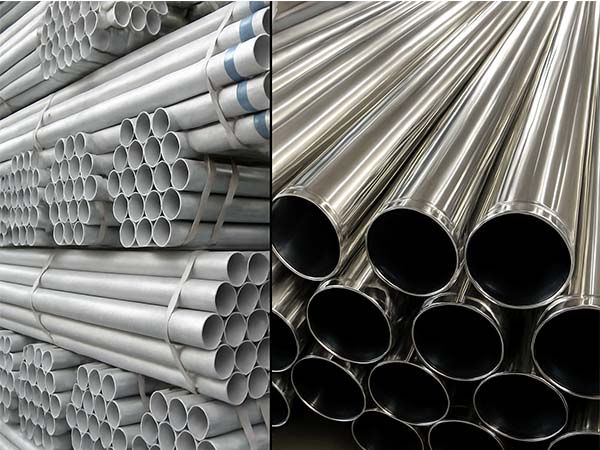Galvanized carbon steel pipes and stainless steel pipes are two key types of steel pipes widely used in the fields of construction, chemical engineering and industry. The reasonable selection of materials for pipelines directly affects the overall quality of the project. Therefore, accurately choosing galvanized carbon steel pipes and stainless steel pipes is particularly important.
What is galvanized carbon steel pipe?
Galvanized carbon steel pipes are made by coating a layer of zinc on the surface of carbon steel. The zinc layer serves as an anti-corrosion barrier, effectively protecting the carbon steel beneath from corrosion. The common method of galvanization is Hot-dip galvanization, which immerses steel in a molten zinc layer. Another method is electro-galvanizing, which involves electroplating a layer of zinc on the surface of carbon steel through electrolysis.

What is a stainless steel pipe?
Stainless steel pipes are produced through a series of processing of stainless steel, which is cast by adding elements such as chromium, nickel and molybdenum to molten steel. Typical examples include 316L or 304. The material itself has a strong anti-corrosion function and does not require additional coating protection.
The main differences between galvanized carbon steel pipes and stainless steel pipes
The materials and manufacturing processes are different
Galvanized carbon steel pipe: The base material is carbon steel. A layer of zinc is plated on the surface of the carbon steel through hot-dip galvanizing or electro-galvanizing methods, thereby playing a role in anti-corrosion.
Stainless steel pipe: Made of stainless steel, it is different from galvanized steel pipe. Stainless steel itself has anti-corrosion properties and does not require coating protection. Stainless steel pipes are usually made from stainless steel billets through welding and seamless processing techniques.
The principles of corrosion resistance are different
Galvanized carbon steel pipe: The anti-corrosion function of galvanized carbon steel pipe is achieved by forming ZnO/ZnCO₃ on the surface zinc layer, which blocks the contact between carbon steel and corrosive media, thereby protecting the base material of the carbon steel pipe. If the zinc coating is damaged, the surrounding zinc coating can also react with corrosive media first, forming a protective film at the damaged area to prevent carbon steel from being corroded. This method is called sacrificial anode cathodic protection.
Stainless steel pipes: The anti-corrosion function of stainless steel pipes mainly lies in the chromium element within them. It can form a self-healing oxide film on the surface of the stainless steel pipes, providing stronger resistance to acids and alkalis.
Strength is different from mechanical properties
Galvanized pipe: strength depends on carbon steel, tensile strength about 370-550 MPa, ductility 15-30 %.
Stainless steel tube: Tensile strength up to 515-1300 MPa, ductility 40-60 %, excellent impact toughness.
Different costs
Galvanized pipe: The material is carbon steel. Compared with stainless steel, it is cheaper in price and easier to process. However, regular inspections are required and maintenance costs may increase the overall cost.
Stainless steel pipes: The cost of stainless steel pipes is relatively high, and the initial investment cost is significantly higher than that of galvanized steel pipes. However, stainless steel pipes require less maintenance and have a longer service life. In terms of long-term use, they are more cost-effective.
Different application fields
Galvanized carbon steel pipes are typically used in outdoor water supply, agricultural equipment, general buildings, water treatment facilities and other fields where corrosion is not too severe.
Stainless steel pipes are typically used in fields such as oil and gas, chemical processing, Marine engineering, and infrastructure.
When choosing between stainless steel pipes and galvanized steel pipes, many factors need to be considered. CENTRAL STEEL is a leading manufacturer, exporter and distributor of steel pipes and fittings in China. We can help you determine the materials that best suit your needs.